Biofuels, Energy Security, and Global Warming Policy Interactions
Within the past two years, there has been a significant movement in political consensus towards an energy future with a substantially larger renewable energy component. One of the major drivers is the perception that importing over 60% of our oil reduces our national security. A recent estimate of the hidden cost of oil dependence amounts to about $3/gal. of liquid fuel excluding multiplier effects (Copulos, 2007). This estimate includes incremental military costs, supply disruption costs and direct economic costs. Many argue that energy security is a major issue that must be addressed in today’s policy environment. Another issue is global warming. The United States now acknowledges that global warming is real and that it is caused by human interventions.
Over two dozen national and international corporations have joined forces with environmental groups to ask Congress to enact cap and trade policies in the United States as quickly as possible (U.S. Climate Action Partnership, 2007). The link between biofuels and global warming is that biofuels, especially cellulosic based biofuels, emit much less carbon dioxide into the atmosphere than conventional petroleum sources. While all biofuels provide greenhouse gas (GHG) emission reductions, cellulosic ethanol can, under certain production conditions, be carbon negative; that is, it actually sequesters carbon even after including the CO2 released when the ethanol is used in vehicles. If we are able to enact cap and trade GHG policy in the near future, biofuels would receive a credit through the cap and trade system. In other words, the GHG emissions reduction achieved by biofuels could be sold to other entities needing to purchase the reductions. However, we will assume here that the U.S. does not adopt a cap and trade system quickly, so other policy mechanisms will be needed to credit biofuels for their GHG emission reductions.
So what we have with biofuels is two kinds of market failures, that economists call externalities. The first is energy security, and the second is GHG emissions linked to global warming. Economists argue that externalities need to be “corrected” through taxes, subsidies, or some form of regulation. While the nation may be paying an energy security cost of up to $3/gal. for liquid fuels, consumers do not pay that cost at the pump. Markets, in other words, have no way of incorporating the energy security cost into the market transaction. To correct that market failure, we must either put an additional, substantially higher, tax on petroleum fuels, subsidize alternatives to petroleum, or create fuel standards that require liquid fuel vendors to procure a certain percentage of their liquid fuels from domestic alternatives to petroleum. In the U.S. political context, the tax route is very unlikely to happen, so we will focus in this paper on alternative fuel subsidies and fuel standards. Since our energy security is increased in direct proportion to the extent to which a domestic petroleum alternative displaces petroleum, we will focus on petroleum import displacement in this analysis.
Similarly, there is currently no market mechanism to “price” GHG emission reductions achieved by biofuels. Thus, if we want to credit biofuels for that reduction, we will need to have a GHG credit incorporated into our subsidy mechanism. In the rest of this paper, we will discuss and evaluate a set of alternative biofuel policies that could be designed to achieve the energy security objective alone or the energy security and GHG reduction objectives together.
Ethanol Economics
Ethanol has been produced for fuel in the United States for almost 30 years. The
industry launch was initiated by a subsidy of 40 cents per gallon provided in the Energy
Policy Act of 1978. Between 1978 and today, the ethanol subsidy has ranged between 40 and
60 cents per gallon. The federal subsidy today is 51 cents per gallon. Throughout all the
history, the subsidy has always been a fixed amount that is invariant with oil or corn prices
(Tyner and Quear, 2006).
Ethanol gets its value from the energy it contains and its additive value. Ethanol has value as a gasoline additive because it contains more oxygen than gasoline (and therefore causes the blend to burn cleaner) and because it has a much higher octane than gasoline (112 compared with 87 for regular gasoline). Historically, ethanol prices have been higher than gasoline because of the additive value and because of the federal and state subsidies. It is interesting to portray these values in terms of the relationship between crude oil price and the maximum a corn dry mill could afford to pay for corn at each crude price (Tyner and Taheripour, 2007).
Figure 1 displays the relationships between crude oil price and break-even corn price on the basis of energy equivalence, energy equivalence plus additive value (assumed to be 35 cents per gallon for this illustration), and energy equivalence plus additive value plus the current federal blending subsidy of 51 cents per gallon. The energy equivalence line was done assuming a figure of 70 percent, slightly more than the direct energy equivalent. Using Figure 1 one can trace out the break-even corn price for any given crude oil price. For example, with crude oil at $60/bbl., the break-even corn price is $4.72/bu. including both the additive premium and the fixed federal subsidy. This figure is for a new plant and includes 12 percent return on equity and 8 percent debt interest. If we consider an existing plant with capital already recovered, we add $0.78 per bushel to yield a break-even corn price of $5.50. It is important to note that additive value is currently 20 cents higher than the value assumed here, so ethanol producers can afford to pay another 53 cents per bushel under current market conditions, which are not likely to persist.
During the twenty year period 1984-2003, crude oil prices ranged between $10 and $30 per barrel, with only one very short term peak above $30. With crude oil prices in that range, the fixed federal subsidy did not put significant pressure on corn prices. However, with crude oil today around $60, there is significant pressure on corn prices. Ethanol investments in the United States have been during the past three years highly profitable with very short payback periods. This high profitability has attracted significant new investment in the industry and added substantially to corn demand. In just a few months, corn prices are up from about $2.25 to around $3.60 per bushel, an increase of about 60 percent. This leap in corn prices is leading to an emerging opposition to ethanol subsidies on the part of animal agriculture, export markets, and other corn users. Some are also concerned about the $4 billion cost of the subsidy in 2007 that will grow rapidly as ethanol production increases.
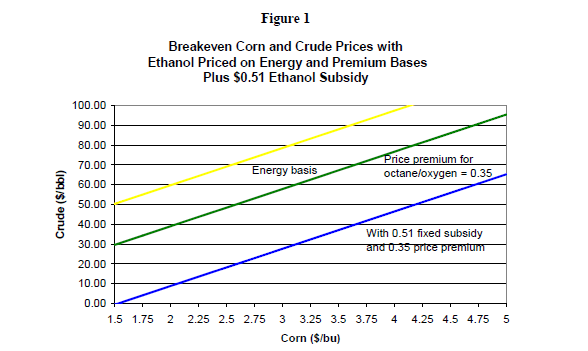
Future Policy Alternatives
In essence, we are living an unintended consequence of the fixed ethanol subsidy.
When it was created, no one could envision $60 oil, but today $60 oil is reality, and many
believe oil prices are likely to remain high. So given this reality, what future federal policy
options could be considered that would support the ethanol industry but provide less incentive
for rapid growth in the industry leading to abnormally high corn prices? There are several
possible policy alternatives that could be considered:
• Make no changes and let the other corn using sectors (particularly livestock) adjust as
needed.
• Keep the subsidy fixed but reduce it to a level more in line with crude oil prices
around $60.
• Convert the subsidy from a fixed subsidy to one that varies with the price of crude oil.
• Construct a subsidy policy with two components: 1)a national security component
(either fixed or variable) tied to energy content of the fuel, and 2)a component tied to
GHG emissions reductions of the liquid fuel.
• Provide higher subsidies for cellulose based ethanol in hopes of accelerating
development and implementation of that technology.
Use an alternative fuel standard instead of subsidies to stimulate growth in production
and use of alternative fuels
• Use a combination of an alternative fuel standard and a variable subsidy
No changes
Certainly, one option is to do nothing – to let the other corn using sectors adjust to
higher corn prices. But as can be seen from the results in the ethanol economics and
sensitivity analyses sections above, that option could lead to substantially higher corn prices
than we have seen historically. It certainly would lead to higher costs for the livestock
industry (is happening already) and ultimately for consumers of livestock products. It also
would lead to reduced corn exports. The breakeven corn prices provided above are
maximums the ethanol industry could pay to retain profitability. Whether these prices would
be reached would depend on the rate of growth of the ethanol industry compared with the rate
of growth of corn supply. The March planting intentions report revealed an expected corn
planted acreage of 90.5 million acres, and increase of 15 percent over 2006. With that report,
the high corn prices moderated somewhat. However, we can certainly expect to see continued
pressure on corn prices if no change is made in federal subsidy policy.
Lower fixed subsidy
Since the current pressure on corn prices comes from the combination of $60 oil and
the 51 cent per gallon subsidy, one option would be to maintain a fixed subsidy but lower it to
a level more in line with the higher oil price. Figure 2 depicts the corn breakeven prices with
a 25 cent per gallon subsidy instead of the current 51 cent per gallon subsidy. The corn
breakeven price for $60 oil becomes $3.90 instead of $4.72 under current policy. However,
the fixed subsidy still has the disadvantage of not responding to possible future changes in oil
prices. If oil fell to $40, the corn breakeven would be $2.84, and it would be $4.43 for $70
oil.
Variable subsidy
Both the current fixed subsidy and a variable subsidy are intended to handle the
energy security externality described above. In designing a variable subsidy, there are two
key parameters: the price of crude oil at which the subsidy begins, and the rate of change of
the subsidy as crude oil price falls. We will illustrate the variable subsidy using $60 crude as
the point at which the subsidy begins. That is, when crude is higher than $60, there is no
subsidy, but some level of subsidy exists for any crude oil price lower than $60. In this
illustration, we will use a subsidy change value of 2.5 cents per gallon of ethanol for each
dollar crude oil falls below $60. Thus, if crude oil were $50, the subsidy per gallon of ethanol
would be 25 cents. If crude oil were $40, the ethanol subsidy would be 50 cents per gallon.
Therefore, for any crude oil price above $40, the ethanol subsidy would be lower than the
current fixed subsidy. For any crude price less than $40, the subsidy would be greater than
the current fixed subsidy of 51 cents per gallon.
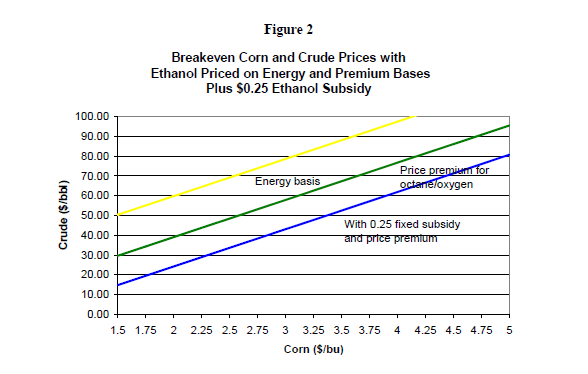
Figure 3 illustrates the corn break-even price for different crude oil prices if this variable subsidy were in effect. In this case, the corn break-even price at $60 oil for a new ethanol plant would be $3.12 per bushel, compared to $4.72 with the fixed subsidy shown in Figure 1. With oil at $50, the corn break-even would be $2.90 for a new plant with the variable subsidy. $40 oil would support a corn price of $2.69 for a new plant and $3.47 for an existing plant with capital recovered. $70 oil would yield a breakeven corn price of $3.65 with no ethanol subsidy. So the variable subsidy provides a safety net for ethanol producers without putting inordinate pressure on corn prices.
For any crude oil price above $60, there is no ethanol subsidy with the variable subsidy, so ethanol plant investment decisions are made based on market forces alone instead of being driven by the federal subsidy. For any crude price between $40 and $60, the variable subsidy is less than the fixed subsidy thereby providing less incentive to invest and less pressure on corn prices, but maintaining a safety net. However, with the fixed subsidy, ethanol plant investment decisions continue to be heavily influenced by the government subsidy even at crude oil prices that render ethanol very profitable in the absence of a subsidy.
Two part subsidy
The two part subsidy derives directly from the theoretical model provided above. For
this illustration, we will construct the national security part of the subsidy based on energy
content of the renewable fuel. Thus, ethanol from corn or cellulose would have the same
energy security subsidy since they have the same energy content, but biodiesel would have an
energy security subsidy 1.5 times larger since it has 150% of the energy content of ethanol.
Similarly, biodiesel would have a larger GHG reduction component than corn ethanol but lower than cellulose ethanol because of the differences in GHG emission reduction. The GHG component would be invariant with the price of crude oil, but the energy security part could be fixed or variable. In this illustration, we will assume, it is fixed.
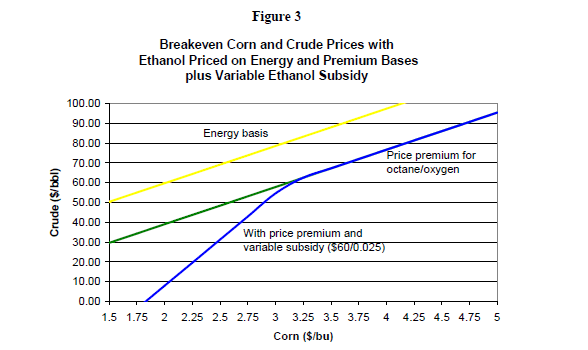
Hill, et al. (2006) indicate that corn based ethanol provides a 12.4% reduction in GHG (compared to gasoline), and soy biodiesel provides a 40.5% reduction (compared to diesel). Tilman, Hill, and Lehman (2006) indicate that switchgrass can actually be carbon-negative; that is, more carbon is sequestered than is released in combustion. For cellulose ethanol, they calculate a 275% reduction in CO2 emissions. Actual carbon balance depends on the production conditions. For purposes of this illustration, we will assume that cellulosic ethanol yields a 200% GHG reduction. One could envision a GHG component of the subsidy keyed to an index. For simplicity, we will use these three percentage figures for the index values for corn ethanol, soy biodiesel, and cellulose ethanol respectively. For the energy security component, we will key it to energy value; that is, to the energy content of oil displaced. The two part subsidy is illustrated in Figure 4. For this illustration, we keyed the base values for the national security component and GHG component to yield a corn ethanol subsidy roughly equivalent to the current federal ethanol subsidy of 51 cents. The base assumptions are 75 cents for the national security component per gallon of gasoline equivalent and 25 cents per gallon for 100 percent GHG emissions reduction.1 The resulting total subsidy values are 53 cents for corn ethanol, 85 cents for soy diesel, and $1.00 for cellulose ethanol. Clearly, these values are just illustrative to demonstrate that a two part subsidy encompassing both the national security and GHG emissions externalities would be possible to accomplish.
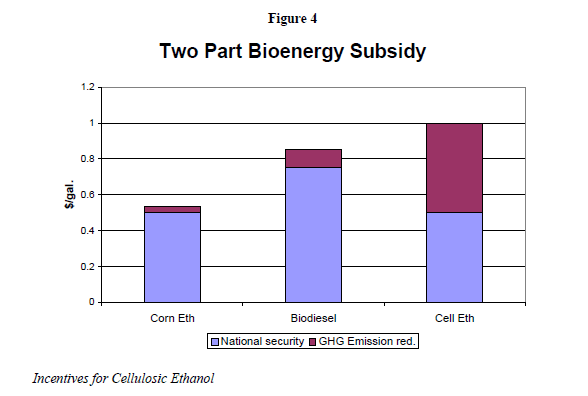
Incentives for Cellulosic Ethanol
Clearly, incorporation of the GHG credit as in the two part subsidy described above
would help stimulate cellulosic ethanol. However, if that is not possible or deemed desirable,
other cellulose targeted incentives may need to be considered. Use of cellulose instead of
corn would also reduce the implications of ethanol production for corn exports and animal
feed. If the state or federal government wants to provide incentives for the industry to move
towards cellulose sources instead of corn, then targeted incentives might be appropriate. One
method would be what is called a reverse auction. In that approach, the government requests
that firms supply some fixed quantity of cellulosic ethanol for the next 10-15 years.
Companies then bid for the contract to supply the ethanol with the lowest bidder winning the
contract. Another option would be to provide a tax credit to cellulose processors for each dry
ton of cellulose converted into fuels. With either of these alternatives, the government could
assist in launching the cellulose-based industry. So long as corn-based ethanol is highly
profitable, it will be difficult to stimulate investment in cellulose technology, because it is
much more uncertain and at present more costly than corn-based ethanol production. Thus,
targeted incentives might be needed.
Alternative fuel standard
In his 2007 State of the Union message, President Bush proposed a relatively large
alternative fuel standard of 35 billion gallons by 2017. That is roughly seven times current
ethanol production. A fuel standard works very differently from a subsidy. It says to the
industry that you must acquire a certain percentage of your fuel from alternative domestic
sources. In the President’s proposal, the sources could be renewable fuels, clean coal liquids
or other domestic sources. With a fuel standard that is perceived to be iron-clad, the industry
is required to procure these alternative fuels no matter what their cost in the market. Most of
the change in cost of the fuels is passed on to consumers either through cheaper or more
expensive fuel at the pump.2 In other words, if crude oil is much cheaper than alternative
fuels, consumers would pay more at the pump than they would in the absence of the standard.
If it turns out that alternative fuels are less expensive than crude oil down the road, consumers
would actually pay less at the pump. So, in a sense, an alternative fuel standard is a different
form of variable subsidy – one in which consumers see a different price at the pump than they
would without the standard. For either a fixed or variable subsidy, the cost of the incentive is
paid through the government budget. For a standard, consumers do not pay through taxes but
pay directly at the pump.
Figure 5 illustrates the functioning of an alternative fuel standard. The two lines represent $40 and $60 crude oil. The horizontal axis is the cost of the alternative fuel (unknown at this point), and the vertical axis is the percentage change in consumer fuel cost compared to the no standard case. Clearly in the left side of the graph with low alternative fuel costs, consumers see little or no change in fuel cost. But with high costs of alternative fuels (current state of technology), consumers could see significantly higher pump prices. If we want to achieve both energy security and global warming objectives through a standard, then it would be appropriate to partition the standard with a higher fraction being cellulose based fuels.
Alternative Fuel Standard Plus Variable Subsidy
In the event that crude oil prices turned out to be quite low, consumers could see
significantly higher pump prices than without a standard. One option to limit the consumer
exposure would be to combine a variable subsidy with a fuel standard. Essentially, there
would be no subsidy unless crude oil prices fell below some predetermined level, say $45.
Then a variable subsidy would kick in, which would limit the price increase consumers would
see at the pump. In a sense it is a form of risk sharing so that in the event of very low oil
prices, the government budget would take part of the hit instead of pump prices. This option
is illustrated in Figure 6. In this case, the horizontal axis is crude oil price and the curve is
done for a $60 alternative fuel cost. The line on the left side that begins at $45 crude
illustrates the impact of the variable subsidy combined with the fuel standard.
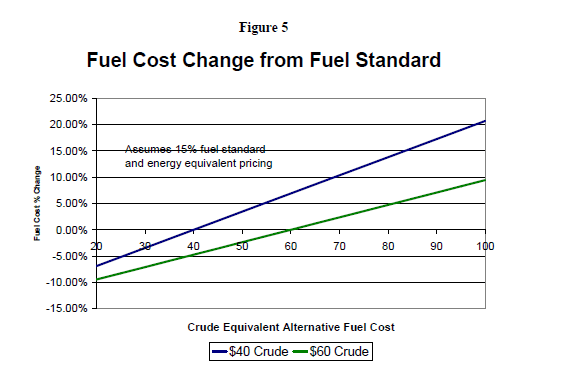
Conclusions
Ethanol has been subsidized in the US since 1978, and the subsidy has ranged from 40
to 60 cents per gallon over that period. Currently the subsidy is 51 cents per gallon, and
combined with $60 oil, ethanol production has become highly profitable. This profitability
has stimulated a huge increase in ethanol production capacity with 6 billion gallons of new
capacity under construction as of January 2007. This increase in ethanol production is
increasing corn demand and prices. Under the current policy, ethanol producers could still
invest profitably in new production with corn price as high as $4.72/bu. Other assumptions
could yield substantially higher corn prices.
One option, clearly, is to make no change in current policy. With this alternative, the other corn using sectors such as livestock production and corn exports would be forced to make the needed adjustments. Less corn would be used in these sectors, and prices for all livestock products likely would increase.
If government is interested in reducing upward pressure on corn prices, alternatives to the current fixed 51 cent per gallon subsidy could be considered. One option would be to lower the fixed subsidy. This alternative would reduce the pressure on corn prices but would still provide ethanol subsidies under higher oil prices when they are not needed. It is also invariant to underlying market conditions.
A second option would be a variable subsidy that provided an ethanol subsidy, which changes with the crude oil price. The option evaluated in this paper provided no subsidy for crude oil price above $60, and a subsidy that increased 2.5 cents per gallon for each $1 crude price is below $60. This option yields a breakeven corn price for $60 oil of $3.12/bu. compared with $4.72/bu under the current policy.
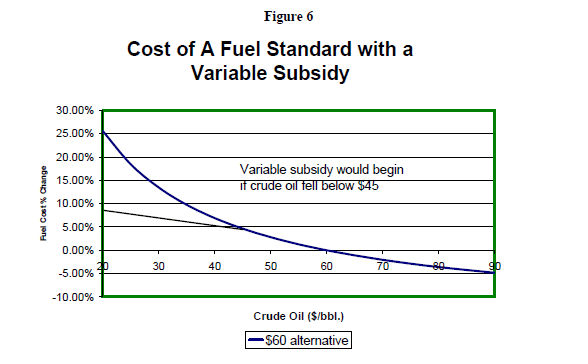
If we want to correct both the energy security and global warming market failures, we can adopt a two-part subsidy that combines credits for energy security with credits for GHG emissions reductions. That option would provide a greater incentive for cellulose based ethanol. If it is not attractive, other cellulose targeted incentives could be considered. Instead of continuing subsidies, another policy path would be to switch entirely to alternative fuel mandates. The mandate approach takes the cost of stimulating production and use of alternative fuels off the government budget and, instead, puts it directly on the pump price of liquid fuels. If we want to consider both the energy security and global warming dimensions, then it would be appropriate to partition the standard between corn and cellulose based ethanol. If the risk of high pump prices in the face of possible low oil prices is deemed unacceptable, another policy alternative would be an alternative fuel mandate combined with a variable subsidy that kicked in at very low oil prices. In that way, higher pump prices could be avoided if oil prices were quite low.
What is very clear is that much work is needed in delineating the impacts of alternative policy pathways. This paper attempts to illustrate some of the alternatives that will need to be considered.
by Wallace E. Tyner - Purdue University
This article hasn't been commented yet.


Write a comment
* = required field